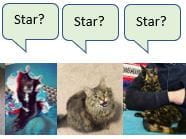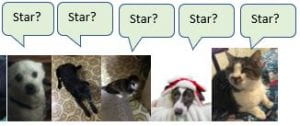Written by Mara Frazier, Curator of Dance at the Jerome Lawrence and Robert E. Lee Theatre Research Institute at The Ohio State University.
Take a moment to close your eyes and take a deep breath, filling up your belly. Let it out through your mouth. Teaching is hard. Teaching library instruction in a one-shot, during a global pandemic, is especially challenging.
Challenges in library teaching are many and include:
- tricky instructor requests
- library anxiety
- limitations to the 50-minute 1-shot
Moreover, the Covid-19 pandemic has destabilized us. Due to Covid we must learn new tech tools and teach online and hybrid instruction. Covid has put an added emotional and cognitive load on students. All of this can make it hard to convey the information that we need to get across in a one-shot.
In 20+ years of teaching dance, I found that sustainable, transformative teaching always accounts for the mind and body. As crazy as it may seem to apply dance instruction ideas in the library, I believe that it is quite sensible.
The key is the common ground of the body.
What I am about to say is both obvious and profound: We all have a body.
It is with/through/in a body that we sense, process, and navigate the environment.
This is obvious and yet we often forget its import. We might focus more on the information we need to get across in a teaching session than on the ways our students will experience it in. By changing our orientation towards learning to account for the way mind and body work together, we can improve student engagement in our classrooms.
Here, I’ve gathered a few examples of how this plays out in the dance classroom and paired the examples with thoughts about how to implement this–in fact, how I do implement this–in library instruction.
I hope in this list of 7 things, you find something you might want to try in your next one-shot to increase the engagement of your students.
1. More listening, less talking.
Chances are, you are talking too much in your teaching. (I know I do.)
As a novice dance teacher, I used to take a lot of time to explain the correct ways to do and think about a given movement. I would talk about a movement’s history, other names, and a thousand technical pointers about how to perform a given movement correctly. Meanwhile, students were standing, waiting, with their eyes glazing over. Over the years, I learned that almost anything else worked better. I learned to structure chances to practice early and often into the class. By doing, students could observe and respond to themselves and others.
The next time you are planning library instruction, build in time for listening and doing. Think about where and when to talk less. Where can you pause and offer students the opportunity to talk or experience?
For example, when a student asks a question, instead of answering it, open the question to the class. Try, “Great question. Does anyone have an answer they can contribute?” Or, when teaching a specific search strategy, try starting with an experience before explaining anything about it. Let the students have an experience, respond to it, and go from there.
2. Be Present
Many of us have been taught to prepare, prepare, prepare. But have you ever spent hours developing a beautiful slide deck and handouts only to have to skip the last 40% of the slides and rush through the handout in the class session? Have you ever spent so much time prepping that you have developed an overwhelming assemblage of information that is too much to share, and then become too stressed to connect with students and swore never to teach again?
I have. I’ve done the equivalent in the dance classroom too. This means rushing into and through dance movements in front of students, while forgetting to relate to them as actual humans. This results in stressed students and a stressed instructor. People who are stressed don’t learn well.
I’ve learned to replace some of my prep time with mindfulness meditation or deep breathing. Instead of a detailed document outlining my class plan, sometimes I will do a simple flow chart showing the concepts and activities I intend to engage in. Therefore, I show up more present and responsive.

Figure 1. A simple flow-chart style lesson plan for a dance class. Try something like this instead of a detailed document to free up your time and attention to be present with students.
It is more powerful to be mindfully present than to cover a large batch of information. Next time you’re prepping a lesson, take a step back. Instead of detailing activities and resources down to the word, try simply sketching your class’s flow in a simple flowchart. Then use your remaining planning time to breathe and visualize your class. How do you want students to feel during and after the lesson? How do you want to feel? This is inspired by activist Adrienne Maree Brown’s idea of “more presence, less prep”–a principle of her theory and practice, Emergent Strategy.
3. Embrace Practice
Practice is everything in dance. In dance, a student may at first be unable to accomplish even the most basic step correctly. Take the plie, a bend of both knees with a straight back. Nearly every ballet class begins with a plie. It is only through years of repeated, intentional practice that dance students achieve mastery of this simple step. In the process of repeating it over years, students grow profoundly.
Furthermore, even expert ballet dancers continue to start their daily practice with plies. As an individual returns to this basic movement over the course of a career, they gain new insight into the same movement information.
What if we approached our library teaching sessions with a practice mindset?
We know that students will not achieve mastery in a 50-minute one-off. Therefore, it makes sense to think of the student’s lifelong relationship to information. Even though we may only have one instruction session with them, they will need to access information over and over throughout the course of their lives. What foundational concepts can you give students a chance to practice in your next teaching session, even if they have practiced it before? Can you allow the possibility that students will struggle with their practice, knowing that they may achieve mastery down the road through the struggle?
4. Invite students to explicitly pay attention to their physical sensations
Dance classes often start and end with ritualized opportunities to become aware of sensations. This may include instruction to take a deep breath, to be still, or to sense one’s physical weight supports in a seated or standing position.
Applying a strategy like this doesn’t have to be anything complicated for the library classroom. It can be as simple as an invitation to observe something they see in the room, to observe the temperature, the feel of air on their skin, feel their seat underneath themselves, or take a deep breath. This can be particularly useful when trying to approach an activity or topic that you anticipate can bring up anxiety, like engaging with technology or using complex search strategies. You can offer this as simply as how this article began, by saying “Take a deep breath.”
Explicitly acknowledging the body can feel like an impossible barrier to breach as an instructor. However, in my experience, students love to be given a low-stakes opportunity to become aware of their sensations, breath, or physical location.
5. Try a “brain dance”.
Brain dance comes from creative dance instructor Anne Green Gilbert, who founded the creative dance center in Seattle. Brain dance moves reduce tension, helping students coordinate their breath, body, and focus of their eyes, becoming more ready to learn. When I see students showing tension in their muscles or becoming restless, I offer a brain dance exercise as a quick reset.
A simple, non-threatening, brain dance-inspired exercise to invite students to do during library instruction is to a cross-lateral movement. This is any movement that brings a body part across the body’s center line to the other side. For example (this is the one I use most often), invite students to bring their right fingertips across their body to touch the back surface of their left shoulder. While touching the shoulder, invite them to take a deep breath into the belly and let it out. If you phrase it right, explaining that this is an optional reset to help them focus better on the next phase of a lesson, you can avoid making anyone feel performance anxiety, and give an out to any who are determined not to participate in a movement activity.
Try it out
I hope this post gave you a few physical or mental strategies you’d like to try to increase student engagement in your classroom. Now I will turn it over to you:
How do you already engage students physically in their learning?
Which of these things would you like to try in your next one shot?
How would you tailor it to apply to your subject area?
Let me know in a comment.
References:
Adrienne Marie Brown, Emergent Strategy (Chico: AK Press, 2017).
Anne Green Gilbert, Brain-Compatible Dance Education. (Champaign, Human Kinetics, 2019).















